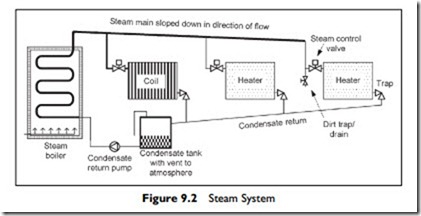Steam
Steam results from boiling water. As the water boils, it takes up latent heat of vaporization and expands to about 1,600 times its original volume at atmospheric pressure. Steam is a gas, and in a vessel, it quickly expands to fill the space available at a constant pressure throughout the vessel. In this case, the relevant space is the boiler(s) and the pipe that runs from the boiler and around the building. The pipe rapidly fills with steam, and the pressure is virtually the same from end to end under no-flow conditions. As flow increases, there is a pressure drop due to friction against the pipe wall and due to the energy needed to produce flow.
When the steam gives up its latent heat of evaporation in an end-use device, such as a coil, fan coil, or radiator, it condenses back to water, and the water is called “condensate.” This condensate is removed from the steam system by means of a “steam trap.” A steam trap is so-named because it traps the steam while allowing the condensate out of the higher-pressure steam system into the lower-pressure condensate return pipe.
Traps are typically thermostatic or float operated.
Thermostatic Trap: In the thermostatic trap, a bellows is used to hold the trap exit closed when heated by steam. The bellows is filled with a fluid that boils at just below the steam temperature. When the trap fills with air or condensate, the temperature drops and the bellows contract, letting the air or condensate flow out. As soon as the air or condensate is expelled and the trap fills with steam, the heated bellows expands, trapping the steam.
Float and Thermostatic Trap: This versatile trap uses the much higher density of condensate to lift a float to open the trap and release the large quantities of condensate produced under startup and high-load periods. When filling the sys- tem, large volumes of air must be vented. The thermostatic element works well for this function. During operation at low loads, the float functions well to drain the slow accumulation of condensate. In most systems, the condensate is gravity-piped to a condensate collection tank, before being intermittently pumped back to the boiler makeup tank. Due to the much smaller volume of condensate, the condensate return piping is smaller in diameter than the steam supply pipe.
Regardless of which trap is used, the returned condensate and any required makeup treated water are pumped into the boiler to be boiled into steam again. The initial water fill and all water added to the steam boiler must be treated to remove oxygen and harmful chemicals that could cause serious corrosion in the boiler and pipe work. The addition of these chemicals means that the water in the system is not potable, not suitable for human consumption. As a result, the steam from the heating distribution system is unsuitable for injecting into the air for humidification. However, the heating steam can be used to indirectly evaporate potable water for humidification, where required.
Because steam has low density and the ability to move itself throughout the system, it is ideal for use in tall buildings. The steam makes its own way to where it is needed and gravity brings the condensate back down again.
Figure 9.2 shows the main components of a small steam system. The condensate is pumped into the boiler where it is boiled into steam. The steam expands down the main and into any heater that has an open valve. As the heater gives off heat, the steam condenses. The condensate collects at the bottom of the heater and is drained away by the trap.
Steam systems are divided into two categories: low-pressure systems and high-pressure systems. Low-pressure systems operate at no more than 15 “psig”, meaning no more than 15 pounds-per-square-inch pressure higher than the local atmospheric pressure. High-pressure systems operate above 15 psig.
Safety Issues
In order to maintain the system pressure, the boiler output needs to be continuously balanced with the load. Because steam has the capacity to expand at high velocity in all directions, a poor boiler operation can cause an accident.
The requirements for boiler operations on low-pressure systems are very much less stringent compared to high-pressure systems. Early in the twentieth century, there were numerous boiler explosions. As a result, the American Society of Mechanical Engineers wrote strict codes for the manufacture of steam boilers and associated piping and equipment. Those codes have drastically reduced the number of failures in North America.
The local pressure vessel regulations are relatively rigorously enforced in most countries. The rules and regulations for both manufacture and operation vary substantially in different countries, so having local information is always a high priority when you are designing or operating a steam pressure system.
Steam systems need to be installed carefully, maintaining a downward slope of 1 in 500 to avoid condensate collecting, called ponding, in the steam pipe. If condensate ponds in the steam pipe and the steam flow increases significantly, a slug of condensate can be lifted and carried by the steam at very high veloc- ity until it reaches a bend or other obstruction. The slug of water can attain a high momentum and may break the joint or valve. Not only can the pipe be ruptured, but as soon as the pipe is ruptured, the steam is free to escape and can easily burn, or kill, anyone in the area.
The advantages of steam are Very high heat transfer.
No need for supply pumps.
Easy to add loads because the system adjusts to balance the loads.
These systems are much less popular than they used to be, but they are still an attractive choice for distribution of large amounts of heat around numerous or high buildings.

